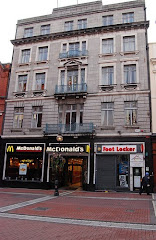Seamus Heaney's "Westering" begins with a detailed description of a map of the moon, comparing its color to that of a frog's skin and its craters to pores, giving it a human quality. The speaker, initially narrating in present tense, then reminisces on his last night in Donegal, not giving us any more information than that, as though the reader is supposed to know where Donegal is and what its significance could be. He then speaks in past tense of an ambiguous "her," describing his shadow on a nameless woman's skin. I took this to most likely be a lover, the way he mentioned his shadow falling across her "bony shine," conjuring images of the two lying beside one another in the moonlight, hearkening back to the opening image of the map. The fourth stanza tells us that "summer had been a free fall / ending there," perhaps referring to their relationship running its course during the summer and ending that last night in Donegal. The next two stanzas show us the two walking, then driving through the town, eventually reaching a church where they constitute only "a dwindling interruption," illustrating their insignificance in lieu of the goings-on at the congregation. Here the poem takes a turn into the religious, referring to the "studded crucifix" and ending by equating the moon with Jesus, giving it "stigmata" and describing "Christ weighing it by his hands" on the moon, the "it" referring either to the "untroubled dust" or the "loosening gravity," or both, in the preceding lines. The present tense also comes back, with the reader saying "I imagine untroubled dust" rather than "imagined."
The unifying symbol of the poem is that of the moon. In the beginning, it is given to us in the form of a map, then the moonlight is employed in the description of the speaker and the woman in Donegal, ending with the moon as a religious symbol, perhaps representative of Jesus himself. The religious tones are more apparent upon the second or third time reading the poem. It starts out with the speaker looking up at the moon and in doing so, presumably looking toward heaven. The moon blankets the speaker and his woman on their last night together, further emphasizing the significance of their connection, as though they were being watched over by God. Good Friday is mentioned, an obvious reference to Christianity as it is a religious holiday. When he refers to the two of them as that "dwindling interruption," it gives the inconsequential feeling associated with being compared to the vastness of the universe, both in a religious and a celestial sense. And finally, Heaney ends with the clear connection between the moon and Christ, cementing it as a religious figure.
The title of the poem is important to consider as well, and how the poem fits into a group of works about emigration. "Westering" implies a move westward, both physically and internally. The speaker refers in the fourth stanza to "the empty amphitheatre / of the west," taking the speaker to another place. If we assume that Donegal is in Ireland, Heaney is discussing the summer he spent there with this woman and how it had to end upon arriving at this amphitheater (as we western Americans would spell it) in the west. But from then on, the poem is still describing the couple--as signified by the use of past tense--and how they went around the town and encountered this religious happening. To me, this could signify the religious turmoil in Ireland, perhaps implying that the speaker left Ireland to escape it. The change in tense, particularly at the end when he returns to present, could signify that the speaker is now in the west, away from Ireland, reflecting on everything that he left there, invoking the image of Christ as another tie-in to the theme of religion.
Subscribe to:
Post Comments (Atom)

This is an interesting analysis; it's probably more along the lines of the actual meaning of the poem than how I saw it when I read it (which is why I didn't write about it initially.)
ReplyDeleteAnyway, I kind of missed the whole symbol of the moon as Jesus Christ (which I kind of like, for reasons I'll go into in a minute), and saw this poem more about the slightly odd juxtaposition of Western ambitions and objects (cars and bikes outside the church) and the Middle Eastern world in which Jesus actually lived. The moon, in my eyes, was the ultimate object of "Western" expansion, after all territory on earth had been mapped out.
However, I like the idea of the moon as a symbol of Christ, albeit limited in the number of parallels between the two, because I am a Christian and I believe in a God with complimentary aspects within His character (God the Father and God the Son; these can be considered to be manifest in nature as day and night.) Now that I am reminded of this idea, I know that I have heard it before, but I had tended to focus on the sun (its bearing of light, its status as the central point of the solar system, and not the earth, even the source of its energy--nuclear fusion--as a picture of the character of the relationship between the Father and the Son) as a manifestation of God. I'm glad to have read this post which has brought back this perspective to me.